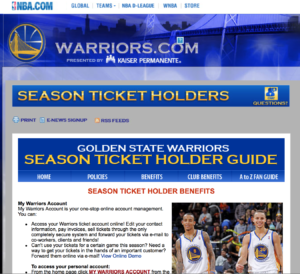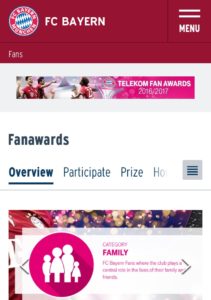In my previous article (article – part 1) focusing on ‘cultivating market places in the business of sports’, I emphasized the importance of acknowledging the interactive nature of information flows. To fully understand a market place, a sports-related organization[1] must be present and active in that market place. So, to apply precision marketing techniques in a successful manner becomes a question of whether your organization invests in knowledge-sharing practices and information flows as part of the co-creation and co-branding processes that should be omnipresent in any sports-related organization.
To understand the premise of the interactive aspect of market places in the postmodern sports economy, the accumulated value from interactions with potential and current customers (e.g. fans and sponsors) is a good indicator. However, to influence a sports-related organization’s market behavior, it is essential to focus on what the sports-related organization measure and how these measurements are conducted as these activities shape the behavior of the organization’s employees and thereby the culture of the organization, how the organization is perceived in the market place and the business opportunities in the market place.
First of all, sports-related organizations, which outrival their competitors, are cognitive about the significance of customer retention and are competent in approaching potential and current customers in an appropriate manner (e.g. kindly, well-informed and service-minded) to account for the importance of customer satisfaction and positive brand transfer effects. Second, these sports-related organizations know that this market behavior leads to a higher probability of good customer loyalty, which is an essential part of the sports branding process. This means that the interactive perspective taken in this approach to the market place highlights that positive interactions with potential and current customers will eventually raise the sports-related organization’s chances to secure a larger, more interactive (better customer involvement and identification that lead to better co-creation and co-branding), more loyal and more profitable customer base. Third, the more frequent a sports-related organization is in touch with its potential and current customers (with positive interactions in mind), it increases the opportunities to boost the profitability of the customer base (also at an individual basis).
From a practical standpoint, just take a look at how the NFL and the New England Patriots benefitted from the Super Bowl hype and interest in the sense that despite winning the Super Bowl in the middle of the night (European time), fans could already shop New England Patriots merchandise associated with the Super Bowl LI title Monday morning, see pictures below. The NFL is at the heart of commercialization in sports and fully understands how to enrich the interactions with fans to increase profitability with fresh merchandise offers and other promotional specials. The Patriots merchandise display on NFL’s web site is well-orchestrated in alignment with sponsorship integration related to the NFL partner Visa. By cultivating the market place, the NFL underscores the importance of turning low-spending customers into average-spending or high-spending customers – or at least the sports-related organization will figure out what customers to prioritize in specific campaigns. In this example, the NFL attempts to benefit on the positive buzz around the Super Bowl performance of the Patriots by trying to get customers to act and to increase the volume of their purchases (i.e. free shipping on orders over $50). Such a tendency is also seen when fans in sport pay to get a number and a name on a jersey (customization is added value for sports teams in terms of monetization and information about fandom priorities). At the same time, it is vital to ‘nurse’ the good customers for what reason sports-related organization engage in special treatments for loyal customers.
Photos: Examples of cultivating the market place by the NFL and New England Patriots.
The Golden State Warriors, see example below, and other sports teams offer special benefits to their season ticket holders to acknowledge that the team appreciates high-spending fans. These special benefits vary from seat upgrades and birthday greetings to special access to the team owner’s room and fan festivals. In the business of sports, it is a general theme to have specific focus on positive attention towards loyal customers. However, there are differences in the execution of these activities. With this in mind, it is interesting for me to see that different Danish football (soccer) clubs have lowered the ticket price to all fan segments (what signals does this send to season ticket holders?). Therefore, it is central that sports-related organizations have asked fans and other stakeholders what they want and thereby evaluate how to put that in play in the most effective way according to the optimization of the entire business model.
Photo: An example of season ticket holder benefits in sports (source: Golden State Warriors).
Another example of good cultivation of the market place in sports is the German football club Bayern Munich. The German powerhouse is very strategic about its position as one of the strongest football clubs and brands in the world. The club has little debt compared to other professional football clubs and is backed financially by acknowledged domestic corporations that are familiar with operating in a global market place. In other words, Bayern Munich is also a powerhouse concerning its economic status in the football economy and is sparked with a somewhat conservative spending policy (for a top club at this level). The club’s debt-to-revenues ratio shines out positively compared to its competitors on a global scale and thus raising the financial sustainability of a club not reliant solely on a solo foreign investor or on a big chunk of debt. This is supplemented by extremely high commercial revenues, i.e. merchandise, sponsorship, stadium tours and so on. FC Bayern Munich differentiates the interactions with selective fan segments, see. picture below. For instance, they are rewarding fans within categories like ‘creative/out of the box’, ‘family’, ‘community service’ by letting them take part in the Telekom sponsored ‘Fan Awards’.
Photos: How FC Bayern Munich works strategically on cultivating its customer base via web site and mobile app.
The strategic focus for the club is to sustain a business model with continued revenue growth, which is based on success on the pitch as this translates easier into working on success off the pitch. So, the club works hard to develop, recruit and retain good talent in a football economy in which German clubs face hard competition from English Premier League clubs that are sparked by much stronger broadcasting deals. Bayern Munich’s performances are also boosted by strong links with the German national team, e.g. a phenomenon that was visible in Germany’s success in international competitions like the 2014 FIFA World Cup in Brazil. This is due to the club’s status as a strong breeding ground for talent development as the youth academy is quite fruitful and given the fact that the club’s financial capacity helps to bring in profile players from competing Bundesliga teams. Bayern Munich strategically utilizes this position for commercial reasons in combination with the club’s strong legacy and from the stabilized partnerships with Adidas, Allianz and Audi. These corporations are also shareholders of the club, which provides a strong core on and off the pitch and reflects the importance of professional sports being a matter of co-creation and co-branding in the pursuit of growing the revenue potential and enhancing the market position. One philosophy that makes the club stand apart from other top clubs in the game of football is that the club has a ticket pricing process founded on a social basis. Access to the team and the games are affordable for €150 (see video below) for tickets in the standing area of Allianz Arena for the home games in the Bundesliga. This is a perfect example of great cultivation as the value of the football experience exceeds that of the price (at least from my personal perspective) compared to for instance many clubs in other football leagues, e.g. the English Premier League. The club emphasizes the importance (and that is aligned with the philosophy of many other German clubs) that the game belongs to the fans for what reason the access to the stadium should not only be a matter of “deep pockets” (see video below). Of course, the club can capitalize on its brand status in terms of high prices for various segmented areas of the Allianz Arena, e.g. hospitality boxes or business seats. However, FC Bayern Munich’s approach may reflect the social model, which differentiates the market place around German football clubs, i.e. the 50+1 rule that protects the clubs from ending in the hands of foreign majority investors (instead this rule keeps close ties between the club and the fans/members). The clubs in Germany want to protect the “roots of football” (see video below), i.e. the fans going to the venue, so it is important to apply a ‘very segmented’ approach to stakeholder relationships as expressed in Bayern Munich.
The segmented approach to cultivating the market place is also present in a global sports business like Bayern Munich as the process of cultivation has motivated the club to open offices in New York City and Shanghai. This conveys the club’s ability to take its strong home market brand to a similar brand status globally, which is essential in monetizing on the brand’s global recognition. Money-making strategies are significant for Bayern Munich but what comes to mind when looking at the difference between Bayern Munich and many other sports businesses is the sustainability of the club and its close relationship to its fans, members and sponsors (especially Allianz, Audi and Adidas as shareholders), e.g. the club does well in selling season tickets. To secure future growth, the club has concentrated on cultivating a market like India (e.g. the Bayern Munich Youth Cup in India and focusing on young Indian talents to hype the club’s strategic focus in the market while playing Oliver Kahn’s last exhibition match before retirement in India), which in volume is massive. However, it is rather undeveloped for what reason it makes sense to implement sporting and commercial activities in India in close collaboration with the club’s sponsors.
Video: Insight into the business of FC Bayern Munich.
[1] ”Sports-related organization is a term that refers to sports entities that have sport as a core function….. The terms sports-related entities and sports- related organizations are used interchangeably throughout the dissertation. This comprises sports events, sports leagues, sports clubs, athletes, professional sports teams, sports governing bodies, sports equipment manufacturers and so on. However, it also includes entities where sport is not a core function, but merely something to be applied as a marketing, communication, branding, sponsorship or promotional platform to create ‘added value,’ e.g. Heineken and the company’s engagement in football (soccer) sponsorships.” (Cortsen, 2016, p. 8)






COMMENTS
No comments yet.